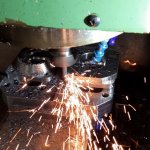Joe Miranda
Titanium
- Joined
- Oct 19, 2004
- Location
- Elyria Ohio
We have been trying to use adaptive machining more and more and have not really found a scientific approach to selecting the depth of cut and step over amounts. We are currently cutting some gray iron with 1/2 carbide endmills at 1" doc and 1/8" step over @ 200sf and 16 ipm feed rate.
I love the material removal rate but we occasionally snap endmills. I would really rather not do that but I want to maximize material removal on this job. To give you an idea - the blocks start at 150lbs and finish at 15lbs - that's a lot of material. In the future they will be cast near to finish - these are prototypes.
What have you guys found as a sweet spot? Thanks.
I love the material removal rate but we occasionally snap endmills. I would really rather not do that but I want to maximize material removal on this job. To give you an idea - the blocks start at 150lbs and finish at 15lbs - that's a lot of material. In the future they will be cast near to finish - these are prototypes.
What have you guys found as a sweet spot? Thanks.
Last edited:



